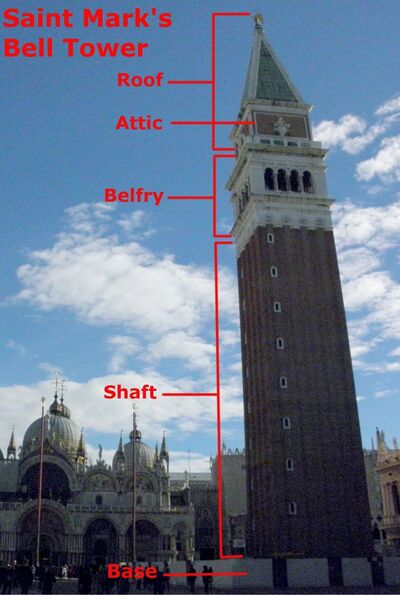Bell tower
This article contains information about a typical Venetian bell tower. For an overview of all the bell towers, see Bell towers.
This section needs improvement.
A Venetian bell tower, known in Italian as campanile, is used to house many Bells. A bell tower is typically named based on the church_LINK it is associated with.
Bell Tower Structure

There are four main components to the structure of a bell tower: base, shaft, belfry, and spire. Each of these contributes to the overall style and integrity of the tower.
Base
The main purpose of the base is to maintain the structural integrity of the tower. The walls at the base of the tower are often thicker than those at the top. Non-porous materials are used so that it is resistant to salt water from flooding and heavy enough to withstand the pressure from the weight of the tower.
Shaft
The shaft is the part that contributes to the height of the tower and contains stairs, ramps, and landings that lead to the belfry. It is usually constructed of brick and mortar, which varied in strength based on the year that it was constructed. Brick makers improved upon the method for making bricks so that bricks could withstand a greater amount of pressure. In addition, to provide the tower with greater flexibility and support, some towers were built using metal rods.
Belfry
The belfry, located above the shaft, contains the bells and usually some type of landing. On the exterior, it is generally the most ornate part of the tower, built using brick and other types of stone or clay. Typically, there are windows or arched openings that let light through and occasionally netting to keep pigeons from entering. The bells are hung from the top of the belfry with wood, although some newer towers use metal. It has been found, however, that the vibration of the bell through the metal to the walls increases deterioration.
Roof
Above the belfry there may be an attic which provides additional storage or access to the top of the tower for maintenance. There may also be a balustrade, or a balcony with a railing that runs around the outside of the attic. This is usually accessible from the attic, so that one may enjoy a more expansive view and have additional access to the roof. To get to the attic, there is either a ladder or stairway.
The spire varies depending on the tower, but it can have many shapes: conical, pyramidal, bulbous, and others. There also may be a lightning rod or weather vane at the top of the tower.
Architectural Style
Like most buildings, there are many different styles of tower architecture. Over the centuries many of the towers have seen numerous renovations resulting in overlapping styles, causing the original style to be virtually indistinguishable. Their eclectic nature reflects the city's history and the diverse ideas that evolved in Venice. Overall, bell towers contribute a great deal to the ambiance of the city.
For more information on architectural styles, see External Links.
Bell Tower Maintenance

This section needs improvement
Catastrophic events such as earthquakes and flooding do not frequently cause any major damage, but deterioration is possible if the bell towers are not maintained properly. Although modern technology has reduced the need to ring the bells manually, it has resulted in people being removed from the process of maintaining those bells and their towers.
Location
MAP
See Also
Bell Towers
Bells
Bell
Bell Ringing
Church
NAVIGATION_BOX for bells
NAVIGATION_BOX for bell towers
References